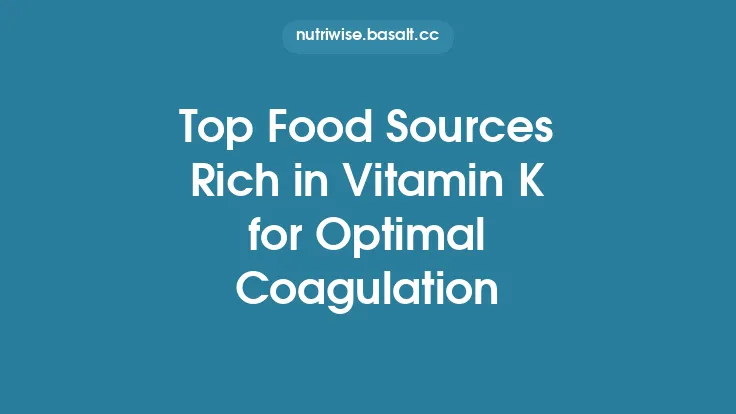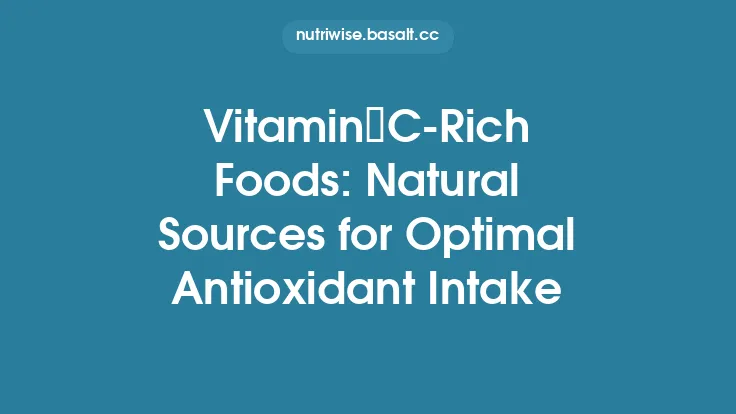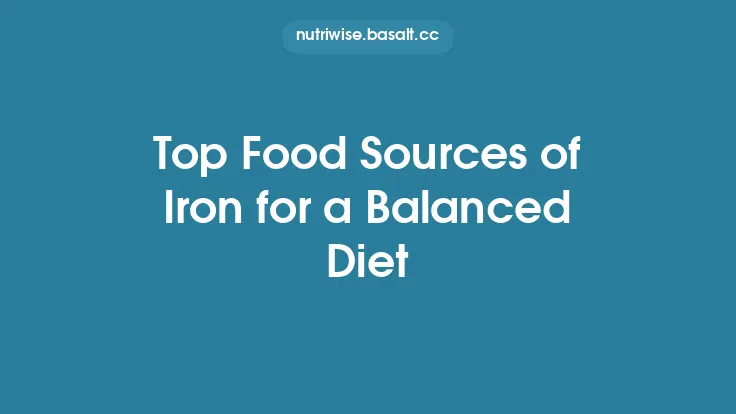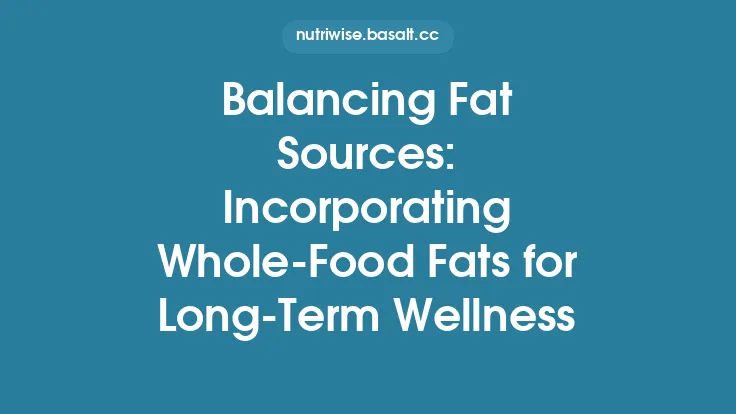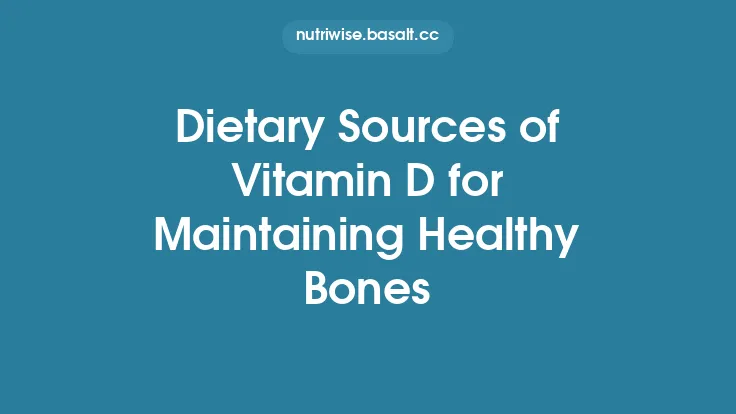Vitamin E is a fat‑soluble micronutrient that the body cannot synthesize, so it must be obtained through the diet. Because it is readily incorporated into cell membranes, a steady intake of vitamin E‑rich foods helps maintain the integrity of cells throughout the body. Below is a comprehensive guide to the foods that provide the highest amounts of vitamin E, how to maximize their nutritional value, and practical ways to include them in everyday meals.
Understanding the Forms of Vitamin E in Foods
Vitamin E is not a single compound but a family of eight related molecules: four tocopherols (α, β, γ, δ) and four tocotrienols (α, β, γ, δ). The α‑tocopherol form is the most biologically active in humans and is the basis for the Recommended Dietary Allowance (RDA). However, many plant foods contain a mixture of tocopherols and tocotrienols, each contributing to the overall antioxidant capacity.
- α‑Tocopherol – Predominant in most animal‑derived foods and many fortified products. It is the form most efficiently retained in the bloodstream.
- γ‑Tocopherol – Common in nuts, seeds, and certain vegetable oils; it has unique anti‑inflammatory properties.
- Tocotrienols – Found in high concentrations in rice bran, barley, and certain palm oils; they are more potent antioxidants in vitro and may support cardiovascular health.
When evaluating food sources, the total vitamin E content (expressed as International Units, IU, or milligrams of α‑tocopherol equivalents) reflects the combined activity of all these forms.
Top Natural Sources of Vitamin E
| Food (≈ 100 g) | Vitamin E (IU) | Primary Vitamin E Forms | Key Nutrients that Aid Absorption |
|---|---|---|---|
| Wheat germ oil | 20,000 IU | α‑tocopherol, γ‑tocopherol | Healthy fats (oil itself) |
| Sunflower seeds | 35 IU | α‑tocopherol | Polyunsaturated fats |
| Almonds | 25 IU | α‑tocopherol | Monounsaturated fats, magnesium |
| Hazelnuts | 21 IU | α‑tocopherol | Monounsaturated fats, copper |
| Pine nuts | 19 IU | α‑tocopherol | Polyunsaturated fats |
| Peanut butter (smooth) | 9 IU | α‑tocopherol | Fat content, protein |
| Spinach (cooked) | 5 IU | α‑tocopherol | Iron, lutein |
| Swiss chard (cooked) | 4 IU | α‑tocopherol | Vitamin K, magnesium |
| Avocado | 2 IU | α‑tocopherol | Monounsaturated fats, potassium |
| Olive oil (extra‑virgin) | 1.9 IU per tbsp | α‑tocopherol | Monounsaturated fats |
| Broccoli (cooked) | 1.5 IU | α‑tocopherol | Vitamin C, fiber |
| Mango | 1.2 IU | α‑tocopherol | Vitamin A, fiber |
| Tomato (raw) | 0.9 IU | α‑tocopherol | Lycopene, vitamin C |
*Values are approximate and can vary with cultivar, growing conditions, and processing.*
Why These Foods Stand Out
- High Fat Content – Since vitamin E is fat‑soluble, foods that naturally contain healthy fats (nuts, seeds, oils, avocado) provide a matrix that enhances absorption.
- Synergistic Micronutrients – Many vitamin E‑rich foods also supply other antioxidants (vitamin C, carotenoids) and minerals that support overall cellular health.
- Low Processing Loss – Vitamin E is relatively stable but can degrade with excessive heat, light, and prolonged storage. Whole, minimally processed foods retain the most activity.
Maximizing Vitamin E Retention During Cooking and Storage
| Food | Best Preparation Method | Reason |
|---|---|---|
| Nuts & Seeds | Roast at ≤ 300 °F (150 °C) for ≤ 10 min; store in airtight containers in a cool, dark place | High heat and prolonged exposure to air oxidize tocopherols. Light‑proof containers slow degradation. |
| Leafy Greens (Spinach, Swiss Chard) | Lightly steam (2–3 min) or sauté quickly with a small amount of oil | Steaming preserves cell structure and releases fat‑soluble vitamin E into the cooking oil, improving bioavailability. |
| Avocado | Eat raw, add to salads or smoothies | Heat destroys the delicate tocopherol structure; raw consumption retains full content. |
| Olive & Other Vegetable Oils | Store in dark glass bottles, keep refrigerated after opening | Light and heat accelerate oxidation; refrigeration slows it down. |
| Wheat Germ Oil | Use as a finishing oil (drizzle on salads, soups) rather than for high‑heat cooking | The oil’s high unsaturated fat content makes it prone to oxidation at cooking temperatures. |
Practical tip: Pair vitamin E‑rich foods with a modest amount of dietary fat (e.g., a drizzle of olive oil over steamed vegetables) to enhance absorption without adding excessive calories.
Incorporating Vitamin E‑Rich Foods Into Daily Meals
Breakfast
- Almond‑Berry Yogurt Parfait: Layer plain Greek yogurt with a handful of toasted almonds, fresh berries, and a drizzle of honey. The almonds supply ~25 IU of vitamin E, while the yogurt adds protein for satiety.
- Smoothie Boost: Blend half an avocado, a cup of spinach, a banana, and a tablespoon of wheat germ oil. This combination delivers > 30 IU of vitamin E in a single serving.
Lunch
- Mediterranean Grain Bowl: Combine cooked quinoa, roasted chickpeas, chopped kale, sliced cucumber, and a generous spoonful of hummus. Top with a tablespoon of extra‑virgin olive oil and a sprinkle of toasted sunflower seeds (≈ 10 IU).
- Nutty Salad: Toss mixed greens with sliced strawberries, crumbled feta, and a vinaigrette made from olive oil, lemon juice, and a teaspoon of mustard. Add a quarter cup of hazelnuts for an extra 5 IU.
Snack
- Seed Mix: Mix equal parts pumpkin seeds, sunflower seeds, and pine nuts. A 30‑gram serving provides roughly 10–12 IU of vitamin E and a satisfying crunch.
- Peanut Butter Toast: Spread natural peanut butter on whole‑grain toast and top with thinly sliced banana. One tablespoon of peanut butter contributes about 4 IU.
Dinner
- Stir‑Fry with Cashews: Sauté sliced bell peppers, broccoli, and snap peas in a tablespoon of sesame oil. Add a handful of roasted cashews (≈ 7 IU) just before finishing. Serve over brown rice.
- Baked Salmon with Herb‑Oil Drizzle: While fish is not a primary source of vitamin E, the herb‑oil (olive oil + fresh herbs) poured over the fillet adds ~2 IU per teaspoon, complementing the omega‑3 fatty acids.
Dessert
- Mango‑Almond Sorbet: Blend frozen mango chunks with a splash of almond milk and a tablespoon of almond butter. The almond butter contributes ~5 IU per serving.
Special Considerations for Different Dietary Patterns
| Dietary Pattern | Key Vitamin E Sources | Adjustments Needed |
|---|---|---|
| Vegetarian / Vegan | Nuts, seeds, plant oils, leafy greens, avocado, fortified plant milks | Ensure adequate intake of healthy fats; consider fortified foods (e.g., soy milk with added vitamin E) to meet RDA. |
| Gluten‑Free | Rice bran oil, sunflower seeds, almonds, quinoa, buckwheat | Use gluten‑free whole grains like quinoa and buckwheat as bases for salads and bowls. |
| Low‑Fat | Vitamin E‑rich fruits (mango, kiwi) and fortified low‑fat dairy | Pair with small amounts of healthy fat (e.g., a teaspoon of oil) to improve absorption; otherwise, absorption may be suboptimal. |
| Mediterranean | Olive oil, nuts, seeds, leafy greens, avocado | Naturally aligns with high vitamin E intake; focus on variety to capture different tocopherol forms. |
| Ketogenic | High‑fat nuts (macadamia, pecans), avocado, coconut oil, MCT oil (low vitamin E) | Emphasize nuts and seeds for vitamin E; supplement with a small amount of wheat germ oil if tolerated. |
How Much Vitamin E Do You Need?
The Recommended Dietary Allowance (RDA) for vitamin E (α‑tocopherol) varies by age and sex:
- Adults (19 + years): 15 mg α‑tocopherol/day (≈ 22.4 IU)
- Pregnant women: 15 mg (22.4 IU)
- Lactating women: 19 mg (28.4 IU)
These values assume a mixed diet that includes some fat for optimal absorption. Most people can meet the RDA through a balanced intake of the foods listed above without resorting to supplements.
Potential Pitfalls and How to Avoid Them
- Over‑Processing of Nuts and Seeds – Roasting at very high temperatures or adding excessive salt can degrade vitamin E and introduce unwanted sodium. Opt for dry‑roasted or lightly toasted varieties.
- Storing Oils Improperly – Light and heat accelerate oxidation, turning beneficial tocopherols into harmful peroxides. Keep oils in dark glass bottles, refrigerate after opening, and use them within 3–6 months.
- Neglecting Fat for Absorption – Consuming vitamin E‑rich foods on a very low‑fat diet can lead to poor uptake. Even a teaspoon of oil or a few nuts can dramatically improve bioavailability.
- Relying Solely on Supplements – Whole foods provide a spectrum of tocopherols and tocotrienols, plus synergistic nutrients that supplements lack. Use supplements only under professional guidance, especially if you have a medical condition affecting fat absorption.
Quick Reference: Daily Food Plan to Meet the RDA
| Meal | Food Item | Approx. Vitamin E (IU) |
|---|---|---|
| Breakfast | 2 Tbsp wheat germ oil (in smoothie) | 4,000 |
| Snack | 30 g mixed nuts (almonds, hazelnuts) | 30 |
| Lunch | Salad with 1 Tbsp olive oil + 2 Tbsp sunflower seeds | 45 |
| Snack | 1 medium avocado | 2 |
| Dinner | Stir‑fry with 1 Tbsp sesame oil + 1 oz cashews | 12 |
| Total | ≈ 4,089 IU (far exceeds RDA; a few servings provide the needed 22 IU) |
*Note:* The RDA is modest; the above plan illustrates that even modest portions of several foods easily cover daily needs. Adjust portion sizes to align with caloric goals.
Bottom Line
Vitamin E is an essential, fat‑soluble antioxidant that the body obtains exclusively from the diet. By focusing on a variety of natural sources—especially nuts, seeds, vegetable oils, and leafy greens—you can effortlessly meet and exceed the recommended intake while also enjoying the additional health benefits these foods provide. Simple culinary strategies such as gentle cooking, proper storage, and pairing with healthy fats ensure that the vitamin remains stable and bioavailable. Incorporating these foods into everyday meals not only supports cellular health but also contributes to a balanced, nutrient‑dense diet that can be sustained for a lifetime.
